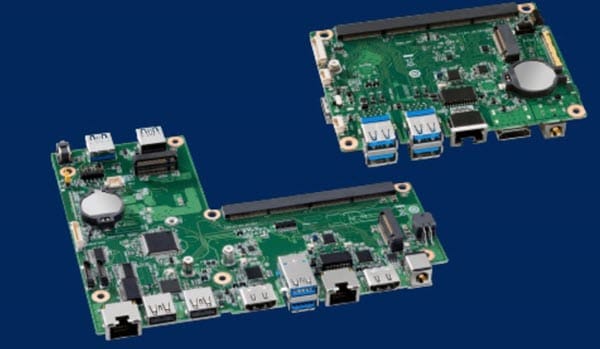A New Creature Processes the Earth

(Source: windwheel/Shutterstock.com)
Hydrodynamic mechanical creations were the first machines to perform automated and sequential functions. Known in modern terms as Rube Goldberg machines, they could perform timing and mechanical functions using gravity, fluid dynamics, frictions, and angular momentum. While primarily used for comical amusement, this educational lesson paved the way for logic, sequencers, bit slice, microcontrollers, and microprocessors.
The new processing creature that has evolved to tackle today's more complex and autonomous machinery needs is the Compute Element from Intel®. It will change the way sophisticated embedded systems are designed, deployed, and used.
A Seed Is Built
The first 4-bit processor introduced from Intel® was the 4004, and while very simple by today's standards, it paved the way for everything we now take for granted. There were no integrated storage peripherals like disk drives, flash subsystems, communications, displays, etc. It merely fetched an instruction, decoded it, executed it, and continued in this simple fashion as an alternative to logic circuits and sequencers. Modern processors still perform these functions, but the integration of peripherals, memory, mathematical, and communications operations has helped them steadily evolve from the simple organism that once was the microcontroller.
And this has been a steadfast and logical evolution of needs-based functionality. Early on, designers realized that all embedded systems needed more than just a processor engine. Functional blocks like UARTs formed the basis of early communications and are still a de facto peripheral in many of today’s compute engines. But as integrated display controllers, disk controllers, DMA, and floating (and fixed) point numeric processors got added to the ever-shrinking geometries of fabricated integrated circuits, it became clear that higher integration was the key.
Higher integration lets engineers work smarter. No longer do they have to create and re-create basic standard functions needed in their systems. Instead, they can focus on the value-added hardware and software required to make their products stand out and outperform their competitors. But does this higher integration need to be monolithic?
The answer is: No.
Introducing the Compute Element
Multi-chip modules (MCMs) are not new and have been the internal basis of chips that mirror and are used like monolithics. Single-board computers, too, have been around and demonstrated their effectiveness by allowing a company to standardize the technology used in the families of their products.
Intel® has created generations of Compute Elements that go above and beyond the merely single board computer and multi-chip module. The new generation of the Intel® NUC 11 (H and U series) are prime examples. These compute elements are built on Intel's 9th generation vPRO I7 cores and go above and beyond a simple, lonely computer. Instead, the family harnesses the ever-expanding capabilities of the cloud and higher-level connectivity like high-speed Wi-Fi® and cellular connectivity to bring more advanced features and capabilities to the design engineers and the products they are developing. In addition, the advanced and integrated graphics capabilities also bring a lot to the designer’s palette (Table 1).
One from Column A, One from Column B, Please
Designing with Intel® NUC Compute Elements begins with choosing the proper series for your needs. The NUC Compute Element includes the processor, memory, and wireless capability for basic compute requirements. The U-Series, for example, is powered by the 8th or 11th generation Intel® Core processors and are ideally suited to digital signage, smart screens, edge analytics, and complex and collaborative workstations.
H Series Intel® NUC Compute Elements are powered by the 9th generation Intel® Core™ H series processors or the Intel® Xeon® processors. They are aimed at gaming and content creation applications (Figure 1).

Figure 1: The Intel®NUC 9 Pro and Intel® NUC 9 Extreme Compute Elements also provide core processor choices and feature high-performance and ruggedized solutions. (Source: Mouser Electronics)
The Intel® NUC Board Elements, like the CMB2GB, are modular companion boards that contain peripheral functions you may need and desire (Figure 2). These modular additions house the peripherals and ports driven by the Intel® NUC Compute Element. These also contain drivers and hardware for Gig Ethernet ports and Thunderbolt 3 and 4 DCH drivers for Windows 10. In addition, these Board Elements support the Compute Elements that have supporting processor accommodations (Table 1).

Figure 2: Intel® NUC Board Elements unite with Intel® NUC Compute Elements to provide the peripheral hardware and ports needed to create your semi-custom embedded systems using out-of-the-box functionality. (Source: Intel®)
Table 1: The Intel® NUC Compute Elements provide designers the choice of how much horsepower and memory and which peripherals and I/O are supported right out of the box. (Source: Intel®)
|
Intel® NUC Compute Element |
Processor Included |
|
Intel® Core™ i9-11900KB Processor (24M Cache, up to 4.90GHz) |
|
|
Intel® Core™ i7-1185G7 Processor (12M Cache, up to 4.80GHz, with IPU) |
|